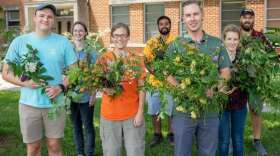In the spring, residents of Appalachia have long enjoyed gathering wild onions known as ramps, but the pandemic has brought more people into the woods in search of edible plants, and that’s led to a 25% increase in calls to poison control.
That’s why the Master Naturalists of Virginia have teamed up with UVA to produce a free booklet that could help foragers stay safe.
Dr. Chris Holstege heads the UVA/Blue Ridge Poison Center where people who’ve confused their wild plants sometimes call.
“One of the things that comes up in the spring time is individuals foraging for leeks. also known as ramps," he explains. "There’s another plant that comes up that looks similar to it known as American false heliebore. When it first starts to emerge from the forest floor, that gets mistaken as ramps, and people it will cook it into their meals and develop toxicity.”
That’s led to uncomfortable, sometimes deadly symptoms, such as nausea and vomting.
“It can lead to seizures in the worst cases," Holstege says. "Your blood pressure dropping, cardiac dysrhythmias, and potentially death.”
Another common mistake involves the plant best known for killing one of the world’s great philosophers – Socrates. Master Naturalist and Project Leader Alfred Gossens says it looks like some appealing plants native to Virginia.
“Poison hemlock looks very much like a carrot," says Gossens. "It also looks like Queen Anne’s Lace, and Queen Anne’s Lace is not poisonous, and people like it, because it looks pretty.”
Then there are plants that can be eaten – but only when cooked properly. Hostege cites poke weed salad.
“Boil the leaves in water. Throw it out. Boil it again," Holstege says. "That gets rid of the toxin called sapanem.”
He adds that there are plants that change in appearance as they mature.
“Some of these toxic plants, which I think those foragers can identify when they’re adult plants, when they’re very young that’s when they misidentify them for edible plants, and that’s when they run into problems.”
There’s even a plant that’s poisonous or not – depending on when you eat it.
“This time of year May Apple is out. That can cause all your organs to fail, and yet the fruit, when it ripens, is reportedly edible.”
Holstege served as the medical consultant on a booklet written by the Master Naturalists of Virginia’s Old Rag chapter. Project leader Alfred Gossens also describes species dangerous to touch – like giant hog weed.
“It can grow 15-16 feet high. The leaves are four feet wide. If you touch it, and then your hand is exposed to sunlight, you’ll get really big blisters.”
Their publication can be downloaded at no charge, but Holstege says 1,000 copies were printed and will be sent to school nurses and other community leaders who can spread the word to avoid accidental poisonings.
To view and download the book go to : med.virginia.edu/brpc/Socrates.



